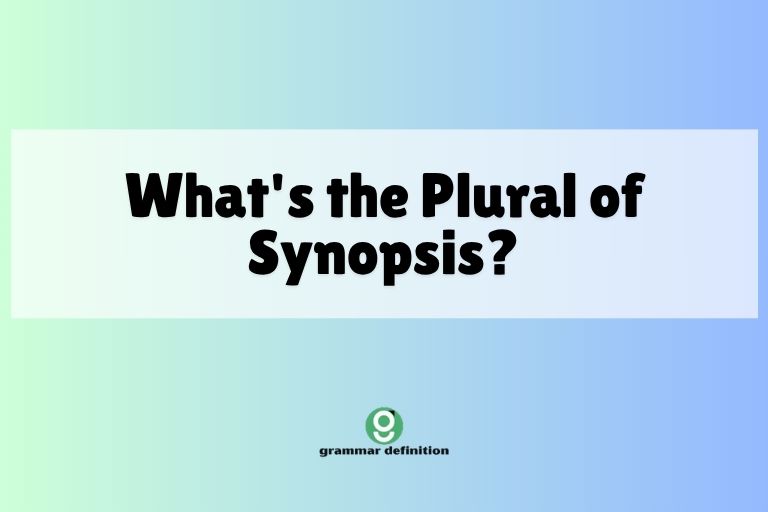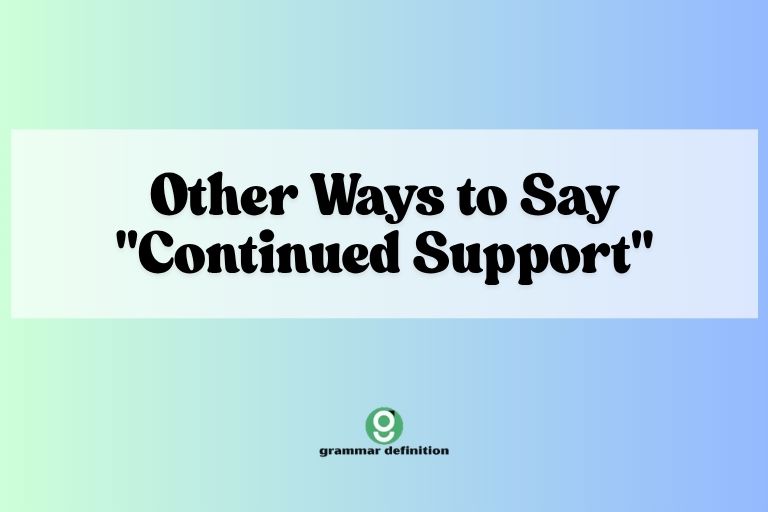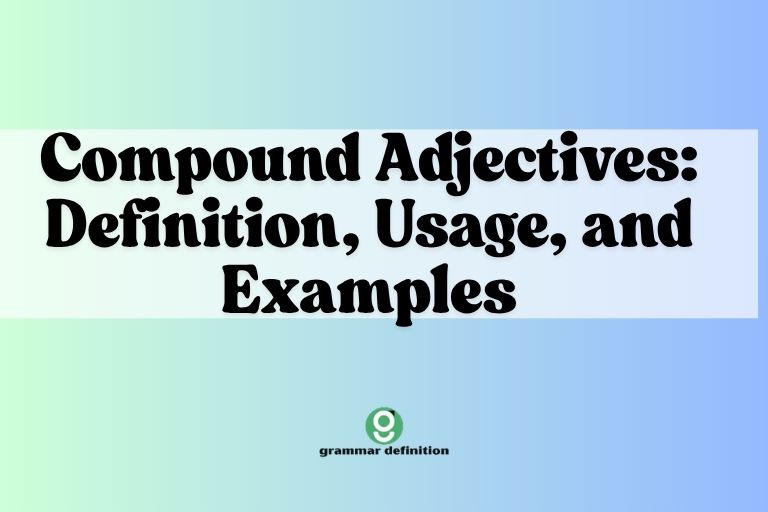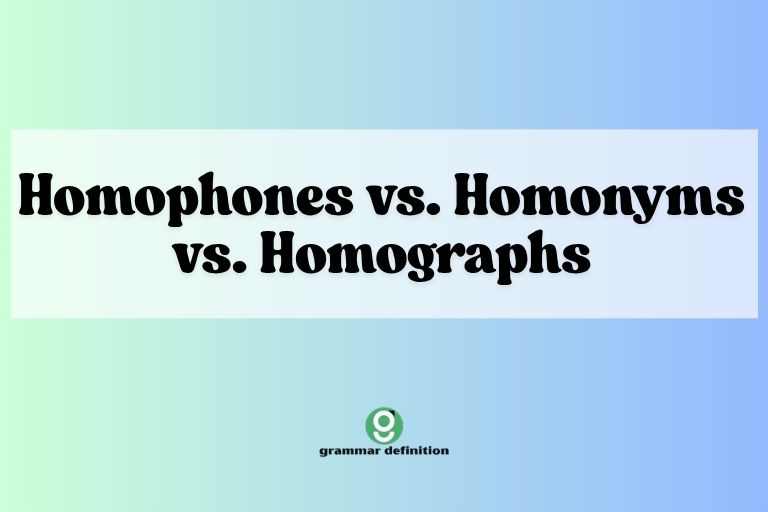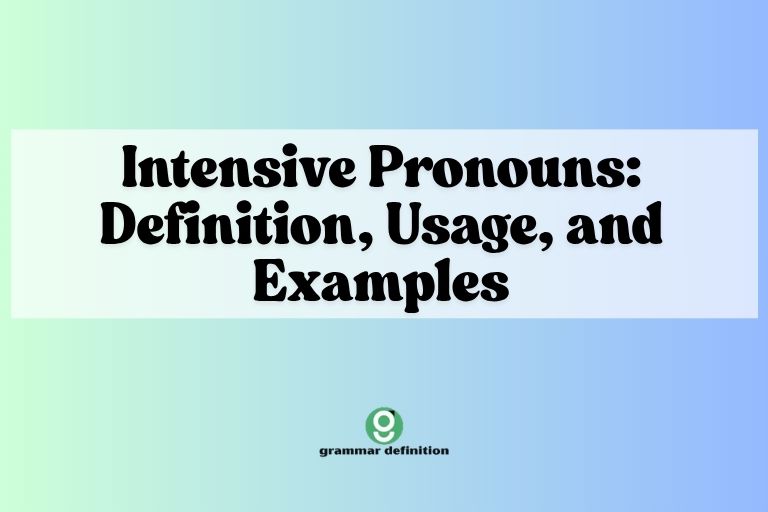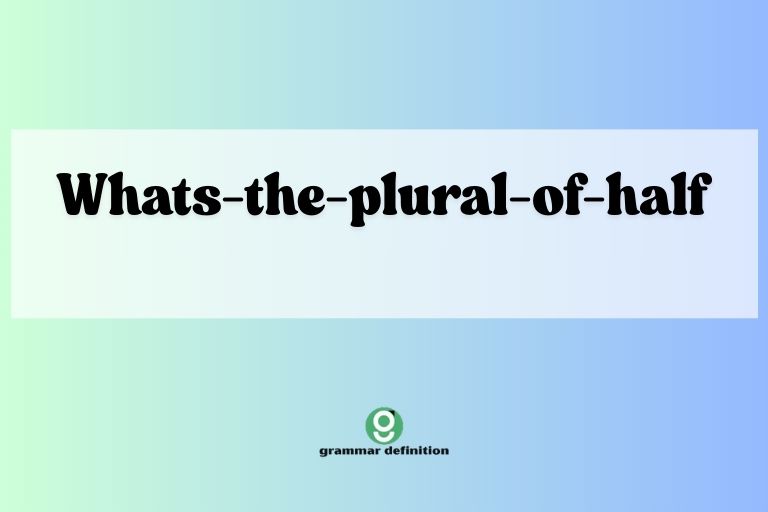Mass Nouns vs. Collective Nouns: A Comprehensive Guide
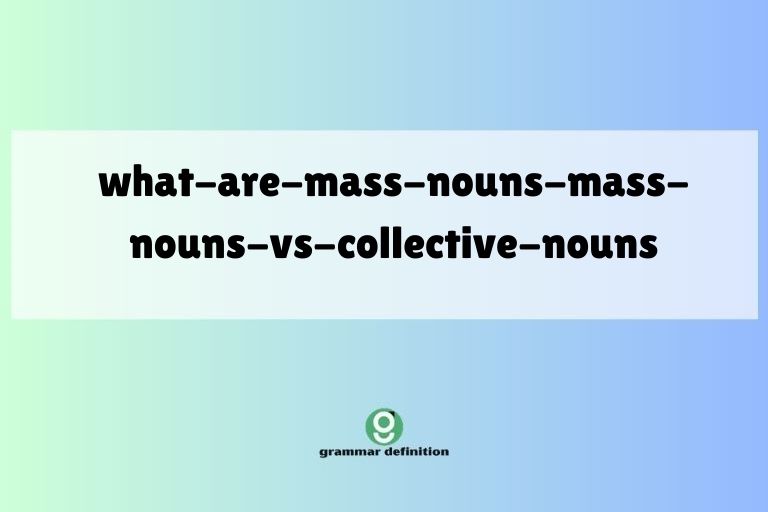
Understanding the nuances of mass nouns and collective nouns is crucial for mastering English grammar. These noun types, while sometimes confused, have distinct characteristics that affect how they are used in sentences.
This article provides a detailed exploration of mass and collective nouns, covering their definitions, structures, usage rules, and common mistakes. Whether you are an ESL learner, a student preparing for an exam, or simply someone looking to improve your English skills, this guide will equip you with the knowledge and practice necessary to use these nouns correctly and confidently.
Table of Contents
- Introduction
- Definitions: Mass Nouns and Collective Nouns
- Structural Breakdown
- Types and Categories
- Examples
- Usage Rules
- Common Mistakes
- Practice Exercises
- Advanced Topics
- FAQ
- Conclusion
Definitions: Mass Nouns and Collective Nouns
Nouns are words that represent people, places, things, or ideas. Within the broad category of nouns, mass nouns and collective nouns represent specific subcategories with unique grammatical behaviors.
Distinguishing between them is essential for accurate and effective communication.
Mass Nouns (Uncountable Nouns)
Mass nouns, also known as uncountable nouns, refer to things that cannot be counted as individual units. These nouns typically represent substances, materials, concepts, or abstract ideas. Because they are uncountable, mass nouns do not have a plural form and are generally used with singular verbs.
Examples of mass nouns include: water, sand, air, information, advice, furniture, luggage, rice, sugar, coffee, happiness, knowledge.
Collective Nouns
Collective nouns refer to a group of individuals or things considered as a single unit. These nouns can be a bit tricky because they can take either a singular or plural verb, depending on whether the group is acting as a unified entity or as individual members. The choice depends on the intended meaning of the sentence.
Examples of collective nouns include: team, family, committee, class, audience, crowd, government, jury, staff.
Structural Breakdown
Understanding the structural properties of mass and collective nouns helps in correctly constructing sentences and avoiding common grammatical errors. Each type of noun has specific patterns and rules that govern its usage.
Mass Noun Structures
Mass nouns typically do not take the indefinite articles “a” or “an.” Instead, they are often used with quantifiers like some, much, a little, a lot of, or with units of measurement such as a cup of, a kilo of, a piece of. The verb associated with a mass noun is generally singular.
Examples:
- Correct: “I need some water.”
- Correct: “There is much sand on the beach.”
- Correct: “Information is power.”
- Incorrect: “I need a water.”
Collective Noun Structures
Collective nouns can take either a singular or plural verb, depending on the context. If the collective noun is acting as a single, unified entity, it takes a singular verb.
If the members of the group are acting individually, it takes a plural verb. This is known as notional agreement.
Examples:
- Singular: “The team is playing well.” (The team as a unit)
- Plural: “The team are putting on their jerseys.” (Individual members of the team)
- Singular: “The family is large.” (The family as a unit)
- Plural: “The family are arguing about the vacation plans.” (Individual members of the family)
Types and Categories
Both mass nouns and collective nouns can be further categorized based on their specific meanings and functions. Understanding these categories can help in identifying and using these nouns correctly.
Types of Mass Nouns
Mass nouns can be divided into several categories, including:
- Substances: water, milk, coffee, tea, oil, gasoline, wood, metal, plastic, glass
- Materials: sand, soil, clay, paper, cotton, wool, silk, leather, stone
- Food: rice, sugar, salt, flour, bread, cheese, meat, fruit
- Abstract Concepts: happiness, knowledge, love, peace, education, intelligence, time
- Gases: air, oxygen, nitrogen, helium, smoke, steam
- Activities: swimming, dancing, singing, reading, writing
Types of Collective Nouns
Collective nouns can also be categorized based on the types of groups they represent:
- Groups of People: team, family, committee, class, audience, crowd, government, jury, staff, crew, party
- Groups of Animals: flock (of birds), herd (of cattle), school (of fish), swarm (of bees), pack (of wolves), pride (of lions)
- Groups of Things: bunch (of grapes), set (of tools), fleet (of ships), collection (of stamps), pair (of shoes)
Examples
The following examples illustrate the use of mass nouns and collective nouns in various contexts. These examples are organized into tables to provide clarity and facilitate understanding.
Mass Noun Examples
The table below provides numerous examples of mass nouns used in sentences, demonstrating their typical usage with quantifiers and singular verbs.
| Mass Noun | Example Sentence |
|---|---|
| Water | I drank some water this morning. |
| Sand | There is a lot of sand on the beach. |
| Air | The air is clean and fresh today. |
| Information | I need more information about the project. |
| Advice | He gave me some good advice. |
| Furniture | We bought new furniture for the living room. |
| Luggage | I have too much luggage to carry. |
| Rice | We eat a lot of rice in our family. |
| Sugar | She added a spoonful of sugar to her coffee. |
| Coffee | I prefer strong coffee in the morning. |
| Happiness | Happiness is a state of mind. |
| Knowledge | Knowledge is power. |
| Milk | He drinks a glass of milk every night. |
| Tea | Would you like some tea? |
| Oil | The car needs more oil. |
| Gasoline | The price of gasoline is increasing. |
| Wood | This table is made of high-quality wood. |
| Metal | The bridge is constructed from strong metal. |
| Plastic | Many toys are made of cheap plastic. |
| Glass | The window is made of thick glass. |
| Soil | The plants need rich soil to grow. |
| Clay | Potters use special clay for their craft. |
| Paper | I need some paper to write on. |
| Cotton | These shirts are made of soft cotton. |
| Wool | This sweater is made of warm wool. |
| Silk | She wore a dress of fine silk. |
| Leather | These shoes are made of durable leather. |
| Stone | The house is built from solid stone. |
| Flour | She needs more flour to bake the cake. |
Collective Noun Examples
The table below provides examples of collective nouns used with both singular and plural verbs, illustrating the concept of notional agreement.
| Collective Noun | Singular Verb Example | Plural Verb Example |
|---|---|---|
| Team | The team is playing very well this season. | The team are arguing about their performance. |
| Family | The family is planning a vacation. | The family are deciding on their destinations. |
| Committee | The committee has made its decision. | The committee are expressing their individual opinions. |
| Class | The class is learning about grammar. | The class are working on different projects. |
| Audience | The audience was captivated by the performance. | The audience were clapping enthusiastically. |
| Crowd | The crowd is getting restless. | The crowd are pushing and shoving. |
| Government | The government is implementing new policies. | The government are debating the budget. |
| Jury | The jury has reached a verdict. | The jury are discussing the evidence. |
| Staff | The staff is dedicated to their work. | The staff are taking their breaks. |
| Flock | The flock of birds is flying south. | The flock are scattering in different directions. |
| Herd | The herd of cattle is grazing peacefully. | The herd are moving to a new pasture. |
| School | The school of fish is swimming in the ocean. | The school are darting between the coral reefs. |
| Swarm | The swarm of bees is building a hive. | The swarm are buzzing around the flowers. |
| Pack | The pack of wolves is hunting in the forest. | The pack are howling at the moon. |
| Pride | The pride of lions is resting in the shade. | The pride are protecting their cubs. |
| Bunch | The bunch of grapes looks delicious. | The bunch are individually ripe. |
| Set | The set of tools is complete. | The set are arranged neatly in the box. |
| Fleet | The fleet of ships is sailing to the harbor. | The fleet are preparing for the voyage. |
| Collection | The collection of stamps is valuable. | The collection are organized by country. |
| Pair | The pair of shoes is stylish. | The pair are different colors. |
| Party | The party is deciding on a theme. | The party are contributing different ideas. |
| Orchestra | The orchestra is playing beautifully. | The orchestra are tuning their instruments. |
Mass Nouns vs. Collective Nouns: Comparative Examples
This table provides a direct comparison of mass nouns and collective nouns, highlighting their differences in usage and grammatical behavior.
| Category | Noun | Example Sentence | Explanation |
|---|---|---|---|
| Mass Noun | Water | I need some water. | “Water” is uncountable and used with a singular verb (implied). |
| Collective Noun | Family | The family is happy. | “Family” refers to a group but acts as a single unit, taking a singular verb. |
| Collective Noun (Plural) | Family | The family are discussing their plans. | “Family” refers to individual members acting separately, taking a plural verb. |
| Mass Noun | Information | Information is essential. | “Information” is uncountable and treated as a singular entity. |
| Collective Noun | Team | The team is winning. | “Team” is a group functioning as one unit. |
| Collective Noun (Plural) | Team | The team are celebrating their individual achievements. | “Team” refers to members acting individually. |
| Mass Noun | Rice | We eat a lot of rice. | “Rice” is a mass noun and requires a quantifier. |
| Collective Noun | Jury | The jury has reached a decision. | “Jury” acts as a single entity. |
| Collective Noun (Plural) | Jury | The jury are divided in their opinions. | “Jury” refers to individual members with differing views. |
| Mass Noun | Advice | I need some advice. | “Advice” is uncountable and requires a quantifier. |
| Collective Noun | Staff | The staff is well-trained. | “Staff” acts as a single unit. |
| Collective Noun (Plural) | Staff | The staff are taking different roles in the event. | “Staff” refers to individual members with differing views. |
Usage Rules
Understanding the specific rules governing mass nouns and collective nouns is essential for accurate and effective communication. These rules cover aspects such as verb agreement, quantifier usage, and the use of articles.
Mass Noun Usage Rules
- Singular Verb Agreement: Mass nouns always take a singular verb.
- No Plural Form: Mass nouns generally do not have a plural form, although there are exceptions when referring to different types or qualities.
- Quantifiers: Use quantifiers like some, much, a little, a lot of with mass nouns.
- No Indefinite Articles: Do not use the indefinite articles “a” or “an” with mass nouns.
- Units of Measurement: Use units of measurement (e.g., a cup of, a piece of) to quantify mass nouns.
Collective Noun Usage Rules
- Singular or Plural Verb Agreement: Collective nouns can take either a singular or plural verb, depending on whether the group is acting as a unified entity or as individual members.
- Context is Key: The choice between singular and plural depends on the intended meaning and context of the sentence.
- Consistency: Be consistent in your choice of verb agreement throughout a paragraph or passage.
- Pronoun Agreement: Pronouns referring to collective nouns should also agree in number (singular or plural) with the verb.
Subject-Verb Agreement
Subject-verb agreement is a fundamental aspect of English grammar. It dictates that the verb in a sentence must agree in number (singular or plural) with its subject.
For both mass nouns and collective nouns, this agreement can sometimes be tricky.
- Mass Nouns: Since mass nouns are always treated as singular, they always take a singular verb. For example: “The water is cold.”
- Collective Nouns: The verb form depends on whether the collective noun is viewed as a single unit or as individual members. For example: “The team is playing well” (single unit) vs. “The team are putting on their uniforms” (individual members).
Common Mistakes
Learners often make specific errors when using mass nouns and collective nouns. Recognizing these common mistakes and understanding how to correct them is crucial for improving grammatical accuracy.
Common Mistakes with Mass Nouns
Here are some common mistakes made with mass nouns, along with corrections:
| Incorrect | Correct | Explanation |
|---|---|---|
| I need an advice. | I need some advice. | “Advice” is a mass noun and does not take the indefinite article “an.” |
| The furnitures are new. | The furniture is new. | “Furniture” is a mass noun and does not have a plural form. |
| I have many informations. | I have a lot of information. | “Information” is a mass noun and cannot be pluralized. |
| Give me a water. | Give me some water. | “Water” is a mass noun and does not take the indefinite article “a.” |
| The rices are cooked. | The rice is cooked. | “Rice” is a mass noun and does not have a plural form. |
Common Mistakes with Collective Nouns
Here are some common mistakes made with collective nouns, along with corrections:
| Incorrect | Correct | Explanation |
|---|---|---|
| The team are playing well. (when referring to the unit) | The team is playing well. | When referring to the team as a unit, use a singular verb. |
| The family is arguing about their vacation plans. | The family are arguing about their vacation plans. | When referring to individual members of the family, use a plural verb. |
| The jury has different opinions. | The jury have different opinions. | When emphasizing the individual opinions of the jury members, use a plural verb. |
| The staff is taking their break. | The staff are taking their break. | When referring to the individual actions of staff members, use a plural verb. |
| The class are intelligent. (when referring to the unit) | The class is intelligent. | When referring to the class as a unit, use a singular verb. |
Practice Exercises
These exercises will help you solidify your understanding of mass nouns and collective nouns. Each exercise focuses on different aspects of their usage.
Exercise 1: Identifying Mass and Collective Nouns
Identify whether the underlined noun in each sentence is a mass noun (M) or a collective noun (C).
| Question | Answer |
|---|---|
| 1. I need some information about the course. | M |
| 2. The team is playing very well. | C |
| 3. We bought new furniture for the house. | M |
| 4. The family is planning a trip. | C |
| 5. There is a lot of sand on the beach. | M |
| 6. The committee has made a decision. | C |
| 7. She added sugar to her coffee. | M |
| 8. The audience was very attentive. | C |
| 9. He gave me good advice. | M |
| 10. The staff is dedicated to their work. | C |
Exercise 2: Subject-Verb Agreement with Collective Nouns
Choose the correct verb form (singular or plural) for each sentence.
| Question | Answer |
|---|---|
| 1. The team (is/are) practicing hard. | is |
| 2. The family (is/are) planning their vacation. | is |
| 3. The committee (has/have) submitted its report. | has |
| 4. The class (is/are) working on different projects. | are |
| 5. The audience (was/were) clapping loudly. | were |
| 6. The government (is/are) debating the new law. | are |
| 7. The jury (has/have) reached a verdict. | has |
| 8. The staff (is/are) taking their lunch breaks. | are |
| 9. The flock of birds (is/are) flying south. | is |
| 10. The herd of cattle (is/are) grazing in the field. | is |
Exercise 3: Using Quantifiers with Mass Nouns
Fill in the blank with an appropriate quantifier (some, much, a little, a lot of).
| Question | Answer |
|---|---|
| 1. I need __________ water. | some |
| 2. There is __________ sand on the beach. | a lot of |
| 3. He gave me __________ advice. | some |
| 4. She added __________ sugar to her coffee. | a little |
| 5. We have __________ information about the topic. | much |
| 6. There is __________ milk in the refrigerator. | some |
| 7. I need __________ help with my homework. | some |
| 8. They have __________ luggage to carry. | a lot of |
| 9. We need __________ rice for dinner. | some |
| 10. There is __________ coffee left in the pot. | a little |
Advanced Topics
For advanced learners, it is important to understand the more complex aspects of mass nouns and collective nouns, including cases where mass nouns can be used countably and the subtle nuances of collective noun agreement.
Mass Nouns Used as Countable Nouns
In certain contexts, mass nouns can be used as countable nouns when referring to specific types or instances of the substance or concept. In these cases, they can take a plural form and be used with indefinite articles.
Examples:
- “There are different types of coffee available.” (coffees refers to different varieties)
- “He ordered two beers.” (beers refers to individual servings)
- “The artist used different oils in his paintings.” (oils refers to different types of oil paint)
Nuances of Collective Noun Agreement
The choice between singular and plural verb agreement with collective nouns can be subtle and depend on the emphasis and context. In British English, it is more common to use a plural verb with collective nouns, even when the group is acting as a unit.
In American English, the singular verb is generally preferred unless the emphasis is clearly on the individual members.
Examples:
- British English: “The team are playing well.”
- American English: “The team is playing well.”
FAQ
Here are some frequently asked questions about mass nouns and collective nouns.
- What is the difference between a mass noun and a count noun?
Count nouns can be counted as individual units and have a plural form (e.g., book, books). Mass nouns, also known as uncountable nouns, cannot be counted and generally do not have a plural form (e.g., water, information). Count nouns can be used with “a/an,” while mass nouns cannot.
- Can a mass noun ever be used as a count noun?
Yes, in certain contexts, mass nouns can be used as count nouns when referring to specific types or instances of the substance or concept. For example, “I tried three different wines.”
- How do I know whether to use a singular or plural verb with a collective noun?
Use a singular verb if the collective noun is acting as a single, unified entity. Use a plural verb if the members of the group are acting individually. Consider the intended meaning and context of the sentence.
- What are some examples of collective nouns that are always treated as singular?
Some collective nouns, like furniture or equipment, are always treated as singular, even though they represent a collection of items.
- What are some examples of collective nouns that are always treated as plural?
Collective nouns like police and cattle are typically treated as plural, even though they refer to a group.
- Are there any collective nouns that can only refer to animals?
Yes, there are many collective nouns that specifically refer to groups of animals, such as flock (of birds), herd (of cattle), school (of fish), and pack (of wolves).
- How can I improve my understanding of mass nouns and collective nouns?
Practice is key. Read widely, pay attention to how these nouns are used in context, and do exercises to reinforce your understanding. Focus on identifying the noun type and ensuring correct subject-verb agreement.
- Why is it important to understand the difference between mass and collective nouns?
Correct usage of mass and collective nouns is crucial for clear and accurate communication. Misusing these nouns can lead to grammatical errors and misunderstandings. A solid understanding of these noun types enhances your overall English proficiency.
Conclusion
Mastering the usage of mass nouns and collective nouns is a significant step towards achieving fluency and accuracy in English. These noun types, while distinct, require careful attention to their specific rules and patterns.
By understanding their definitions, structural properties, and common usage errors, you can confidently use them in your writing and speaking.
Remember to practice regularly, pay attention to context, and be mindful of subject-verb agreement. With consistent effort, you can avoid common mistakes and communicate effectively and accurately.
Keep exploring and refining your understanding of English grammar to further enhance your language skills.

